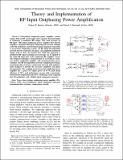Theory and Implementation of RF-Input Outphasing Power Amplification
Author(s)
Barton, Taylor W.; Perreault, David J
DownloadPerreault_Theory-and-Implementation.pdf (13.06Mb)
OPEN_ACCESS_POLICY
Open Access Policy
Creative Commons Attribution-Noncommercial-Share Alike
Terms of use
Metadata
Show full item recordAbstract
Conventional outphasing power amplifier systems require both a radio frequency (RF) carrier input and a separate baseband input to synthesize a modulated RF output. This work presents an RF-input/RF-output outphasing power amplifier that directly amplifies a modulated RF input, eliminating the need for multiple costly IQ modulators and baseband signal component separation as in previous outphasing systems. An RF signal decomposition network directly synthesizes the phase- and amplitude-modulated signals used to drive the branch power amplifiers (PAs). With this approach, a modulated RF signal including zero-crossings can be applied to the single RF input port of the outphasing RF amplifier system. The proposed technique is demonstrated at 2.14 GHz in a four-way lossless outphasing amplifier with transmission-line power combiner. The RF decomposition network is implemented using a transmission-line resistance compression network with nonlinear loads designed to provide the necessary amplitude and phase decomposition. The resulting proof-of-concept outphasing power amplifier has a peak CW output power of 93 W, peak drain efficiency of 70%, and performance on par with a previously-demonstrated outphasing and power combining system requiring four IQ modulators and a digital signal component separator.
Date issued
2015-11Department
Massachusetts Institute of Technology. Department of Electrical Engineering and Computer ScienceJournal
IEEE Transactions on Microwave Theory and Techniques
Publisher
Institute of Electrical and Electronics Engineers (IEEE)
Citation
Barton, Taylor W., and Perreault, David J. “Theory and Implementation of RF-Input Outphasing Power Amplification.” IEEE Transactions on Microwave Theory and Techniques 63, 12 (December 2015): 4273–4283 © 2015 Institute of Electrical and Electronics Engineers (IEEE)
Version: Author's final manuscript
ISSN
0018-9480
1557-9670